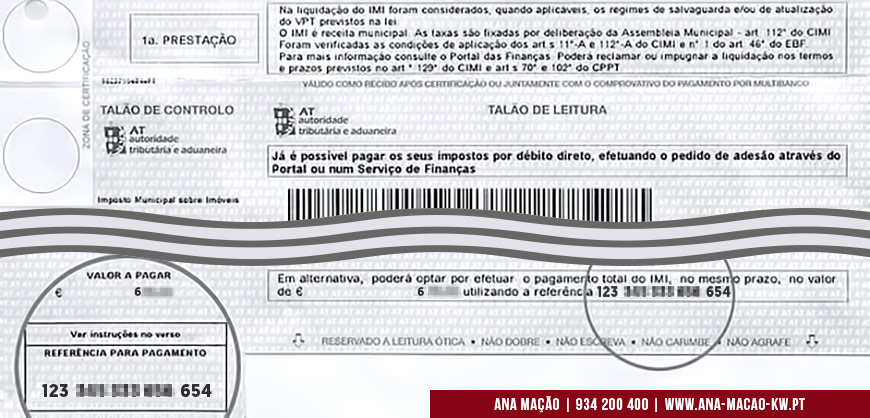How is IMI calculated?
All property owners are subject to annual payment of this tax.Since it is a single tax, it is necessary to pay IMI for each property you own. The following rates apply to the taxable equity value of all the taxpayer's buildings:
- Rustic buildings: 0.8%;
- Urban buildings: 0.5% to 0.8%;
- Appraised urban buildings, under the terms of the CIMI: 0.3% to 0.5%.
IMI is levied on rural buildings, (land located outside an urban agglomeration, not classified as land for construction), mixed (their rustic and urban part cannot be classified as main) and urban (all others.).
And pay whoever is the owner / usufructuary / superficiary of the building on December 31 of the year to which it respects. In the case of undivided inheritances, IMI is due on the undivided inheritance represented by the head of the couple.
IMI exemption
The IMI exemption applies exclusively to urban buildings intended for permanent own housing. The owner has 6 months to use the acquired property as a permanent home.
The application for exemption from IMI must be submitted to the Tax Office where the property is located, within a maximum period of 8 months after the date of completion of the purchase and sale deed. There is only room for an exemption of this type for a taxable person or for the same household.
For a property value of up to €157,500, an exemption from IMI is granted for a period of 6 years. Between €157,500 and €236,250 the IMI exemption period is 3 years. Above this value (€236,250) there is no exemption from IMI.
Also exempt from IMI are properties integrated in undertakings that have been considered of tourist utility. The IMI rates applicable to properties integrated in open-end real estate investment funds, as well as those integrated in closed-end real estate investment funds of public subscription, are reduced by half.
What are the modalities, deadlines and dates of payment of IMI in 2019?
![IMI collection note - Municipal Property Tax]()
The IMI payment dates have recently been changed and from 2019 notifications for payment of the tax begin to arrive from April, and the payment will have to be made in the following month, in May, if you choose the single payment. The notification is sent in writing and through the Finance Portal to the personal account of the property owners.
This tax can be paid in full or in installments if the amount exceeds €100. If it is less than 100€, payment in full is mandatory , in one go. For amounts of IMI over €100, the taxpayer can opt for the single payment or, if desired, pay in installments. The split payment options are:
- In 2 installments - if the total IMI to be paid is less than €500;
- In 3 installments - if the IMI amount exceeds €500 .
If you choose to pay the IMI in installments, the payment months are in May, August and November, depending on the chosen payment method:
- If payment is made in 1 single installment , it will take place in May .
- If payment is made in 2 installments (if the IMI is greater than €100 and less than €500) it will be paid in May and August (in 2 equal parts);
- If the payment is made in 3 installments (if the IMI is equal to or greater than €500) it will be paid in May, August and November (in 3 equal parts);
How to pay IMI?
In the notification received by the owners for payment of IMI there is a reference for payment with the full amount of the tax, and another reference for payment of the 1st installment. If the amount exceeds €100, the taxpayer can choose to settle the tax in the plot, using the respective reference for this.Alternatively, you can choose to settle in stages, paying only the 1st installment (as long as the tax amount is greater than €100) using the 2nd ATM reference.
You also have the option of activating the payment by Direct Debit, through the Finance Portal, with the debit from your bank account being carried out automatically, within the established deadlines.
What happens if I miss the IMI payment date?
After non-compliance, a debt certificate is issued and a tax enforcement procedure is initiated, with the defaulting taxpayer being notified and “invited” to voluntarily pay the debt. The latter has 30 days to do so, counting from the citation date.
This is a situation that you should avoid at all costs and for several reasons, namely:
- Firstly, if you allow the collection period for a given IMI installment to expire, you automatically lose the right to settle it through installments , being obliged to settle the entirety of the tax still owed for that fiscal year. This penalty provided for by law is not always taken to the letter, but this depends on the "kindness" of the respective Finance Department.
- Secondly, it is subject to the payment of default interest, fines and charges related to the process triggered by the Tax Authority. These penalties are subject to the legal framework in force, which in 2019 was:
| Tax offense |
fine |
compensatory interest |
late payment interest |
| Missing or late delivery of the IMT installment |
30% to 100% of the tax due |
4%/year |
4.825%/year
|
-
Of the 3 penalty options, there is one that is applied immediately: default interest. These are calculated using the following formula: missing IMI value x interest rate (annual rate of 4.825% in 2019) x number of missing days ÷ 365 . The number of days is calculated from the date of default to the date of settlement of the missing tax. However, if the taxpayer settles the situation within 30 days, it is customary practice for finance to only consider the date of the summons as the calculation date.
-
Compensatory interest and charges due in the process are added to the missing tax amount. The amount of the fine, in the event of negligence, may not be less than €50 (or €25, in case of fine reduction), nor more than €45,000, if the contrary is not required by law. However, if the taxpayer pays the tax and fails to do so within 30 days of the summons, both the fine and compensatory interest are usually forgiven.
-
If, despite all this, the taxpayer does not regularize his situation, the property may be subject to attachment. However, if the house is the family's residential address, the attachment will not lead to sale at auction, being suspended. Except if the property has a taxable value - VPT greater than €574,000, or if the property is subject to the maximum rate of IMT.
How to download the IMI value?
Asking for a revaluation of the house can help to get a reduction in this tax, especially since the value of properties has been decreasing in recent years. However, before requesting a revaluation of the property for IMI purposes, try to understand whether this could bring you advantages and actually represent a reduction in the tax amount. Use the available simulators to calculate the tax amount and ask for the reassessment only if this amount is lower than that shown in the property booklet. In this case, the building booklet should be updated.
You can also use the Montepio website , updated with the latest changes to the law, in order to assess whether or not it is worth requesting a review of your IMI.







